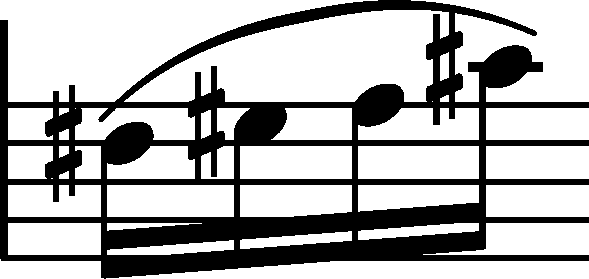



Issues : Errors resulting from corrections
|
b. 43
|
composition: Op. 28 No. 17, Prelude in A♭ major
..
In A one can see that Chopin initially wrote the mordent with a conventional In this place, FCI includes an earlier version – there are no ornaments on the 4th quaver in the bar, while b1 is linked with a tie to the dotted crotchet at the beginning of the bar. category imprint: Differences between sources; Corrections & alterations; Source & stylistic information issues: Annotations in teaching copies , EE revisions , Errors in FE , Corrections in A , Errors resulting from corrections , Deletions in A , Annotations in FES , Main-line changes , Inaccuracies in A |
||||||||||||||||
|
b. 43
|
composition: Op. 28 No. 17, Prelude in A♭ major
..
In A the arpeggio sign merged with the category imprint: Differences between sources issues: Annotations in teaching copies , Errors in FE , Annotations in FED , Errors resulting from corrections , Errors of FC |
||||||||||||||||
|
b. 44
|
composition: Op. 10 No 8, Etude in F major
..
Initially, the 1st group of semiquavers in A was category imprint: Corrections & alterations issues: Corrections in A , Errors resulting from corrections , Cautionary accidentals |
||||||||||||||||
|
b. 44
|
composition: WN 37, Lento con gran espressione
..
The rhythmic notation of A1 gives rise to doubts in this bar, since in spite of the change of time signature to The rhythm of the sources coming from [A2] is generally unambiguous; although it is only in CB that the notation can be considered correct, minor inaccuracies in the remaining sources do not hamper its interpretation. In the main text we give the text of CJ, completed with a rest for the R.H. part, without which the notation could be misleading. category imprint: Interpretations within context; Differences between sources; Corrections & alterations; Source & stylistic information issues: Corrections in A , Chopin's hesitations , Errors resulting from corrections , Deletions in A , Main-line changes |
||||||||||||||||
|
b. 45
|
composition: Op. 50 No. 1, Mazurka in G major
..
In A1 (→FE) there is no category imprint: Interpretations within context; Differences between sources issues: EE revisions , Errors resulting from corrections , GE revisions , Errors of A , Errors repeated in FE |

 mark. In the grace notes added instead of
mark. In the grace notes added instead of  before c
before c 2 merged with the arpeggio sign, resulting in a mark resembling a
2 merged with the arpeggio sign, resulting in a mark resembling a  . Consequently, in
. Consequently, in  . Chopin deleted it and wrote the final version below. It seems that he did not check the influence of the change on the notation of the subsequent part of the bar – there is no
. Chopin deleted it and wrote the final version below. It seems that he did not check the influence of the change on the notation of the subsequent part of the bar – there is no 




 , the bar contains 5 crotchets. Initially, Chopin most probably envisioned triplet movement, like in the version of [A2] (→
, the bar contains 5 crotchets. Initially, Chopin most probably envisioned triplet movement, like in the version of [A2] (→ lowering e1 to e
lowering e1 to e 1. It is a result of inattention at the time of performing corrections in this autograph: originally, it was a crotchet featuring e
1. It is a result of inattention at the time of performing corrections in this autograph: originally, it was a crotchet featuring e